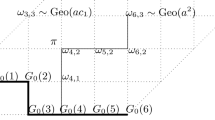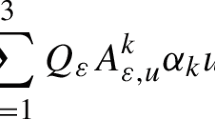Abstract
We prove that the classical line-tension approximation for dislocations in crystals, that is, the approximation that neglects interactions at a distance between dislocation segments and accords dislocations energy in proportion to their length, follows as the Γ-limit of regularized linear-elasticity as the lattice parameter becomes increasingly small or, equivalently, as the dislocation measure becomes increasingly dilute. We consider two regularizations of the theory of linear-elastic dislocations: a core-cutoff and a mollification of the dislocation measure. We show that both regularizations give the same energy in the limit, namely, an energy defined on matrix-valued divergence-free measures concentrated on lines. The corresponding self-energy per unit length \({\psi(b, t)}\), which depends on the local Burgers vector and orientation of the dislocation, does not, however, necessarily coincide with the self-energy per unit length \({\psi_0(b, t)}\) obtained from the classical theory of the prelogarithmic factor of linear-elastic straight dislocations. Indeed, microstructure can occur at small scales resulting in a further relaxation of the classical energy down to its \({\mathcal H^1}\)-elliptic envelope.
Similar content being viewed by others
References
Agmon S., Douglis A., Nirenberg L.: Estimates near the boundary for solutions of elliptic partial differential equations satisfying general boundary conditions. II. Commun. Pure Appl. Math. 17, 35–92 (1964)
Alberti G., Baldo S., Orlandi G.: Variational convergence for functionals of Ginzburg–Landau type. Indiana Univ. Math. J. 54(5), 1411–1472 (2005). doi:10.1512/iumj.2005.54.2601
Alicandro R., Cicalese M., Ponsiglione M.: Variational equivalence between Ginzburg–Landau, XY spin systems and screw dislocations energies. Indiana Univ. Math. J. 60(1), 171–208 (2011). doi:10.1512/iumj.2011.60.4339
Alicandro R., De Luca L., Garroni A., Ponsiglione M.: Metastability and dynamics of discrete topological singularities in two dimensions: a Γ-convergence approach. Arch. Ration. Mech. Anal. 214(1), 269–330 (2014). doi:10.1007/s00205-014-0757-6
Ambrosio L., Braides A.: Functionals defined on partitions in sets of finite perimeter. I. Integral representation and Γ-convergence. J. Math. Pures Appl. (9) 69, 285–305 (1990)
Ambrosio L., Braides A.: Functionals defined on partitions in sets of finite perimeter. II. Semicontinuity, relaxation and homogenization. J. Math. Pures Appl. (9) 69, 307–333 (1990)
Ambrosio, L., Fusco, N., Pallara, D.: Functions of bounded variation and free discontinuity problems. In: Mathematical Monographs. Oxford University Press, Oxford, 2000
Anzellotti G., Baldo S., Percivale D.: Dimension reduction in variational problems, asymptotic development in Γ-convergence and thin structures in elasticity. Asymptotic Anal. 9(1), 61–100 (1994)
Ariza M.P., Ortiz M.: Discrete crystal plasticity. Arch. Ration. Mech. Anal. 178, 149–226 (2005)
Bacon D.J., Barnett D.M., Scattergood R.O.: Anisotropic continuum theory of lattice defects. Progr. Mater. Sci. 23, 51–262 (1979)
Barnett D., Swanger L.: The elastic energy of a straight dislocation in an infinite anisotropic elastic medium. Physica Status Solidi 48(b), 419–428 (1971)
Bott, R., Tu, L.W.: Differential Forms in Algebraic Topology. Springer, Berlin, 1982
Bourgain J., Brezis H.: New estimates for the Laplacian, the div-curl, and related Hodge systems. C. R. Math. Acad. Sci. Paris 338(7), 539–543 (2004). doi:10.1016/j.crma.2003.12.031
Bourgain J., Brezis H.: New estimates for elliptic equations and Hodge type systems. J. Eur. Math. Soc. (JEMS) 9(2), 277–315 (2007). doi:10.4171/JEMS/80
Bulatov, V., Cai, W.: Computer Simulations of Dislocations, Oxford Series on Materials Modelling, vol. 3. Oxford University Press, Oxford, 2013
Cacace S., Garroni A.: A multi-phase transition model for the dislocations with interfacial microstructure. Interfaces Free Bound. 11, 291–316 (2009)
Cermelli P., Leoni G.: Renormalized energy and forces on dislocations. SIAM J. Math. Anal. 37(4), 1131–1160 (2005). doi:10.1137/040621636
Conti, S., Garroni, A., Massaccesi, A.: Modeling of dislocations and relaxation of functionals on 1-currents with discrete multiplicity. Calc. Val. PDE (2014). doi:10.1007/s00526-015-0846-x
Conti S., Garroni A., Müller S.: Singular kernels, multiscale decomposition of microstructure, and dislocation models. Arch. Rat. Mech. Anal. 199, 779–819 (2011). doi:10.1007/s00205-010-0333-7
Conti, S., Gladbach, P.: A line-tension model of dislocation networks on several slip planes. Mech. Mat. (2015, to appear). doi:10.1016/j.mechmat.2015.01.013
Dal Maso G., Murat F., Orsina L., Prignet A.: Renormalized solutions of elliptic equations with general measure data. Annali della Scuola Normale Superiore di Pisa, Classe di Scienze 4a serie 28(4), 741–808 (1999)
De Luca L., Garroni A., Ponsiglione M.: Γ-convergence analysis of systems of edge dislocations: the self energy regime. Arch. Ration. Mech. Anal. 206(3), 885–910 (2012). doi:10.1007/s00205-012-0546-z
El Hajj A., Ibrahim H., Monneau R.: Dislocation dynamics: from microscopic models to macroscopic crystal plasticity. Contin. Mech. Thermodyn. 21(2), 109–123 (2009). doi:10.1007/s00161-009-0103-7
Federer, H.: Geometric measure theory. Die Grundlehren der mathematischen Wissenschaften, Band 153. Springer, New York, 1969
Focardi M., Garroni A.: A 1D macroscopic phase field model for dislocations and a second order Γ-limit. Multiscale Model. Simul. 6(4), 1098–1124 (2007). doi:10.1137/070679181
Friesecke G., James R.D., Müller S.: A theorem on geometric rigidity and the derivation of nonlinear plate theory from three-dimensional elasticity. Commun. Pure Appl. Math. 55(11), 1461–1506 (2002). doi:10.1002/cpa.10048
Garroni A., Leoni G., Ponsiglione M.: Gradient theory for plasticity via homogenization of discrete dislocations. J. Eur. Math. Soc. (JEMS) 12(5), 1231–1266 (2010). doi:10.4171/JEMS/228
Garroni A., Müller S.: Γ-limit of a phase-field model of dislocations. SIAM J. Math. Anal. 36, 1943–1964 (2005)
Garroni A., Müller S.: A variational model for dislocations in the line tension limit. Arch. Ration. Mech. Anal. 181, 535–578 (2006)
Geers M.G.D., Peerlings R.H.J., Peletier M.A., Scardia L.: Asymptotic behaviour of a pile-up of infinite walls of edge dislocations. Arch. Ration. Mech. Anal. 209(2), 495–539 (2013). doi:10.1007/s00205-013-0635-7
Hall C.L., Chapman S.J., Ockendon J.R.: Asymptotic analysis of a system of algebraic equations arising in dislocation theory. SIAM J. Appl. Math. 70(7), 2729–2749 (2010). doi:10.1137/090778444
Hirsch, P.B.: Fifth International Conference on Crystallography, p. 139. Cambridge University, Cambridge, 1960
Hirth, J.P., Lothe, J.: Theory of Dislocations. McGraw-Hill, New York, 1968
Holz A.: Topological properties of linked disclinations in anisotropic liquids. J. Phys. A 24, L1259–L1267 (1991)
Holz A.: Topological properties of linked disclinations and dislocations in solid continua. J. Phys. A 25, L1–L10 (1992)
Holz A.: Topological properties of static and dynamic defect configurations in ordered liquids. Physica A 182, 240–278 (1992)
Hull, D., Bacon, D.J.: Introduction to dislocations, 5th edn. Butterworth-Heinemann, Oxford, 2011
Jerrard R.L.: Lower bounds for generalized Ginzburg–Landau functionals. SIAM J. Math. Anal. 30(4), 721–746 (1999). doi:10.1137/S0036141097300581
Kleman M., Michel L., Toulouse G.: Classification of topologically stable defects in ordered media. J. de Physique 38, L195–L197 (1977)
Koslowski M., Cuitiño A.M., Ortiz M.: A phase-field theory of dislocation dynamics, strain hardening and hysteresis in ductile single crystal. J. Mech. Phys. Solids 50, 2597–2635 (2002)
Koslowski M., Ortiz M.: A multi-phase field model of planar dislocation networks. Model. Simul. Mat. Sci. Eng. 12, 1087–1097 (2004)
Kröner E.: Berechnung der elastischen Konstanten des Vielkristalls aus den Konstanten des Einkristalls. Zeitung der Physik 151, 504–518 (1958)
Mermin N.D.: The topological theory of defects in ordered media. Rev. Modern Phys. 51(3), 591–648 (1979)
Morgan, F.: Geometric Measure Theory. Academic Press, Inc., Boston, 1988. A beginner’s guide
Morrey, J.C.B.: Multiple Integrals in the Calculus Of Variations. Die Grundlehren der mathematischen Wissenschaften, Band 130. Springer, New York, 1966
Müller S., Scardia L., Zeppieri C.I.: Geometric rigidity for incompatible fields and an application to strain-gradient plasticity. Indiana Univ. Math. J. 63, 1365–1396 (2014)
Mura, T.: Micromechanics of Defects in Solids. Kluwer Academic Publishers, Boston, 1987
Nye J.F.: Some geometrical relations in dislocated crystals. Acta Metallurgica 1, 153–162 (1953)
Orowan, E.: Discussion. Symposium on Internal Stresses in Metals and Alloys, p. 451. Institute of Metals, London, 1948
Ponsiglione M.: Elastic energy stored in a crystal induced by screw dislocations: from discrete to continuous. SIAM J. Math. Anal. 39(2), 449–469 (2007). doi:10.1137/060657054
Read, W.T.J.: Dislocations in Crystals. McGraw-Hill, New York, 1953. p. 53
Reina C., Conti S.: Kinematic description of crystal plasticity in the finite kinematic framework: a micromechanical understanding of F = F e F p. J. Mech. Phys. Solids 67, 40–61 (2014). doi:10.1016/j.jmps.2014.01.014
Rice, J.R.: Conserved integrals and energetic forces (Ed. Miller K.J. Fundamentals of Deformation and Fracture. Cambridge University Press, Cambridge, 1985
Saada G.: Sur le durcissement dû à la recombinaison des dislocations. Acta Metallurgica 8, 841–847 (1960)
Sandier E.: Lower bounds for the energy of unit vector fields and applications. J. Funct. Anal. 152(2), 379–403 (1998). doi:10.1006/jfan.1997.3170
Sandier, E., Serfaty, S.: Vortices in the Magnetic Ginzburg–Landau Model. Progress in Nonlinear Differential Equations and their Applications, Vol. 70. Birkhäuser, Boston, 2007
Scala, R., Goethem, N.V.: Dislocations at the continuum scale: functional setting and variational properties (2013, Preprint)
Scardia L., Zeppieri C.: Line-tension model for plasticity as the Γ-limit of a nonlinear dislocation energy. SIAM J. Math. Anal. 44, 2372–2400 (2012)
Simpson H.C., Spector S.J.: On the positivity of the second variation in finite elasticity. Arch. Rat. Mech. Anal. 98(1), 1–30 (1987). doi:10.1007/BF00279960
Simpson H.C., Spector S.J.: Applications of estimates near the boundary to regularity of solutions in linearized elasticity. SIAM J. Math. Anal. 41(3), 923–935 (2009). doi:10.1137/080722990
Stampacchia G.: Le probléme de Dirichlet pour les équations elliptiques du second ordre à coefficients discontinus. Annales du Institut Fourier (Grenoble) 15, 189–258 (1965)
Stein, E.M.: Singular Integrals and Differentiability Properties of Functions. Princeton Mathematical Series, No. 30. Princeton University Press, Princeton, 1970
Taylor G.I.: Mechanism of plastic deformation of crystals. Proc. R. Soc. London A 145, 362 (1934)
Toulouse G., Kleman M.: Principles of a classification of defects in ordered media. J. Physique 37, L149–L151 (1976)
Trebin H.R.: The topology of non-uniform media in condensed matter physics. Adv. Phys. 31(3), 195–254 (1982)
Van Schaftingen J.: Estimates for L 1-vector fields. C. R. Math. Acad. Sci. Paris 339(3), 181–186 (2004). doi:10.1016/j.crma.2004.05.013
Vitek V.: Theory of the core structures of dislocations in body-centred-cubic metals. Crystal Lattice Defects 5, 1–34 (1974)
de Wit G., Köhler J.S.: Interaction of dislocations with an applied stress in anisotropic crystals. Phys. Rev. 116(5), 1113–1120 (1959)
Xu W., Moriarty J.A.: Atomistic simulation of ideal shear strength, point defects, and screw dislocations in bcc transition metals: Mo as a prototype. Phys. Rev. B 54(10), 6941–6951 (1996)
Yang L.H., Soderlind P., Moriarty J.A.: Accurate atomistic simulation of \({(a/2)\langle111\rangle}\) screw dislocations and other defects in bcc tantalum. Philos. Mag. A 1(5), 1355–1385 (2001)
Zehebauer M., Seumer V.: Cold work hardening in stages iv and v of fcc metals—i. experiments and interpretation. Acta Metallurgica et Materialia 45(2), 577–588 (1993)
Author information
Authors and Affiliations
Corresponding author
Additional information
Communicated by The Editors
Rights and permissions
About this article
Cite this article
Conti, S., Garroni, A. & Ortiz, M. The Line-Tension Approximation as the Dilute Limit of Linear-Elastic Dislocations. Arch Rational Mech Anal 218, 699–755 (2015). https://doi.org/10.1007/s00205-015-0869-7
Received:
Accepted:
Published:
Issue Date:
DOI: https://doi.org/10.1007/s00205-015-0869-7




